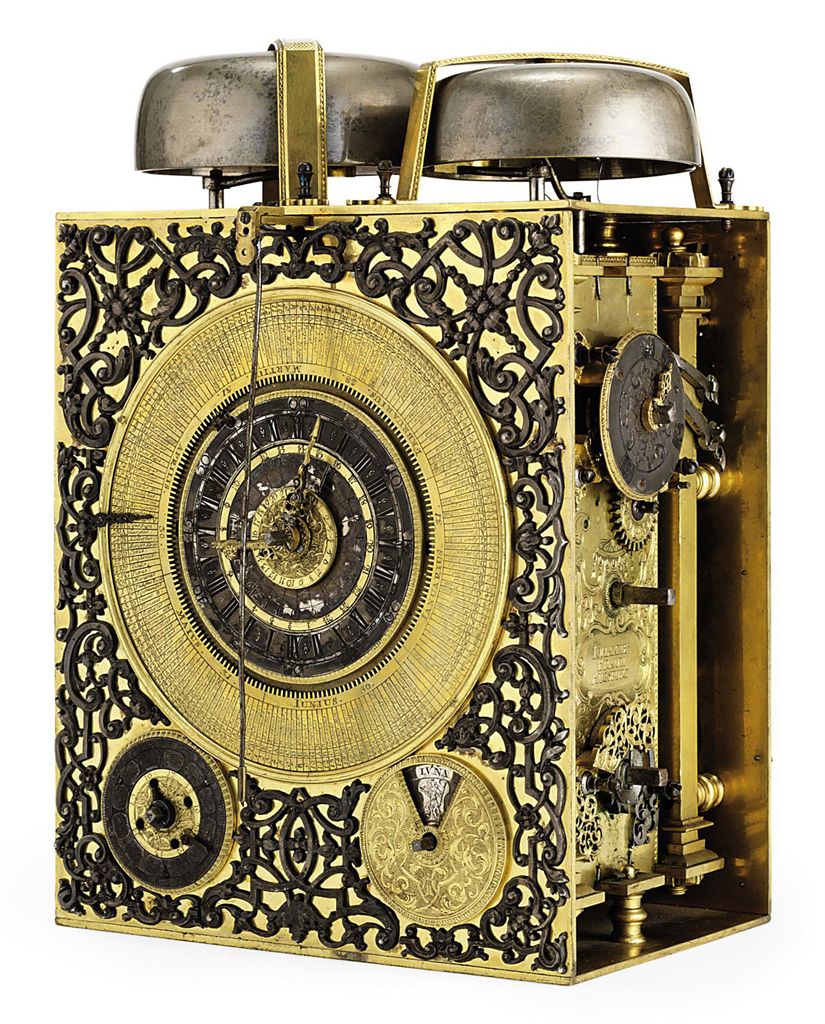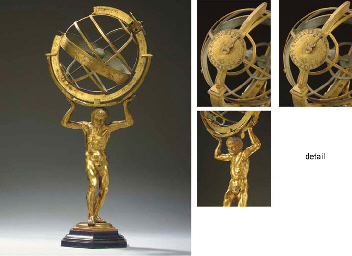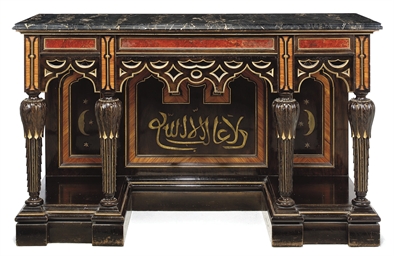A GERMAN GILT BRASS AND SILVERED BRASS CELESTIAL GLOBE, ORIGINALLY WITH CLOCKWORK Attributed to Jost Brgi, circa 1590 This globe was designed to be fitted with clockwork contained within the globe. It no longer has this mechanism, and has been converted from a mechanical globe to an ordinary celestial globe. The present axis of the globe passes through the Ecliptic Pole, and the Earth's Pole is at an angle of 23 to it. On examining this position on the globe, one sees that a hole has been filled. This was to permit a drive to pass through the surface to turn the hands of a 24-hour clock dial. Originally, the two hemispheres forming the globe permitted an index arm to pass between them for indicating the day of the year on the horizon ring. The two hemispheres are now firmly connected by a silvered brass circumferential band. The Stand. This closely follows the design of the stand for the clockwork celestial globe in Zurich by Jost Brgi, dated 1594. A similar stand for an earlier mechanical globe was the work of the Nuremberg goldsmith, Wolff Meyer. The prinicipal supports are finely modelled in the form of satyrs' heads, with lions' heads below, the lower supports being also lions' heads with paw feet. One support is entwined with a serpent, its tail in the mouth of a lion, and its tongue forming an arrow pointer for use with the clockwork-driven horizon ring, no longer operative. The stand is also pierced with various holes, the purpose of which is unknown. Between the supporting brackets is a cylinder with a domed based, through which passes a drive shaft, square sectioned below. The globe is made of copper with a silvered surface (now worn). The constellation figures are finely engraved, but the craftsman has not been identified. The silvered horizon ring is marked out with the calendar, and shows the Holy Days of the Church. The finial is lost. the globe 5 in. (13 cm.) diam. the base 5.2/3 in. (14.4 cm.) diam. 11 in. (28 cm.) high overall
A GERMAN GILT BRASS AND SILVERED BRASS CELESTIAL GLOBE, ORIGINALLY WITH CLOCKWORK Attributed to Jost Brgi, circa 1590 This globe was designed to be fitted with clockwork contained within the globe. It no longer has this mechanism, and has been converted from a mechanical globe to an ordinary celestial globe. The present axis of the globe passes through the Ecliptic Pole, and the Earth's Pole is at an angle of 23 to it. On examining this position on the globe, one sees that a hole has been filled. This was to permit a drive to pass through the surface to turn the hands of a 24-hour clock dial. Originally, the two hemispheres forming the globe permitted an index arm to pass between them for indicating the day of the year on the horizon ring. The two hemispheres are now firmly connected by a silvered brass circumferential band. The Stand. This closely follows the design of the stand for the clockwork celestial globe in Zurich by Jost Brgi, dated 1594. A similar stand for an earlier mechanical globe was the work of the Nuremberg goldsmith, Wolff Meyer. The prinicipal supports are finely modelled in the form of satyrs' heads, with lions' heads below, the lower supports being also lions' heads with paw feet. One support is entwined with a serpent, its tail in the mouth of a lion, and its tongue forming an arrow pointer for use with the clockwork-driven horizon ring, no longer operative. The stand is also pierced with various holes, the purpose of which is unknown. Between the supporting brackets is a cylinder with a domed based, through which passes a drive shaft, square sectioned below. The globe is made of copper with a silvered surface (now worn). The constellation figures are finely engraved, but the craftsman has not been identified. The silvered horizon ring is marked out with the calendar, and shows the Holy Days of the Church. The finial is lost. the globe 5 in. (13 cm.) diam. the base 5.2/3 in. (14.4 cm.) diam. 11 in. (28 cm.) high overall















Try LotSearch and its premium features for 7 days - without any costs!
Be notified automatically about new items in upcoming auctions.
Create an alert